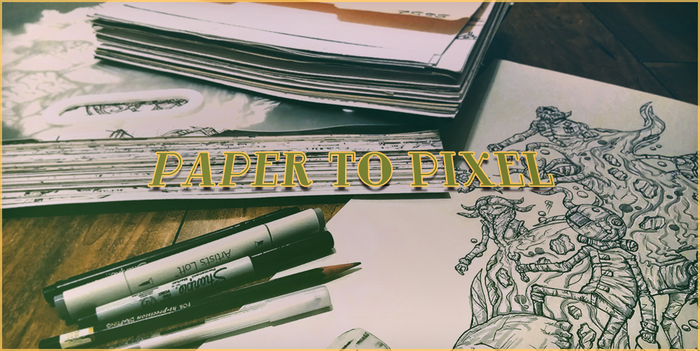
Featured Blog | This community-written post highlights the best of what the game industry has to offer. Read more like it on the Game Developer Blogs.
In April 2015 I took part in a game jam in which you had to create a Twine game using less than 100 Words. These are the lessons I learned during the development of my entry.


Lesson #01: Keep an eye-out for cool jams
Twiny Jam – Make a Twine game in under 300 words.
I read the Tweet and was immediately intrigued. I’ve always wanted to take part in a game jam and although I’d made attempts in the past, they’d always been unsuccessful. I’d also always wanted to make a Twine game, having read about the tool and even played a few games made with it. 300 words wasn’t a lot either and I think this is what ultimately led me to take part in this Jam. The 300 word limit made creating this game unintimidating as I felt it could probably be done in a few hours. On top of all of this it was Easter weekend and my wife was working long shifts, so I’d be in the house alone, free to jam for a couple of days.
Lesson #02: Try something new
I set to work, firstly learning the toolset. From what I could tell, twine has 2 versions, the older desktop version and a newer in-browser version. I opted for the desktop version as a part of me didn’t trust using the in-browser version to save my progress. Twine is a great bit of kit, easy to pick up and simple to use. Plus there are a bunch of helpful tutorials and resources online. Once I had a handle on Twine I started brainstorming ideas for a game.
Lesson #03: Don’t settle on the first idea you think of
My first idea drew inspiration from my time working in a call centre trying to sell PAT Testing. The game would be a series of dialogue options that would lead the player to make a sale or the person on the end of the phone would say nasty thing to you and hang up. When they hung up, the player would *sigh* and make another call. The game would be an endless loop just like my days in that call centre. Call after call after call. Every call would go one of a number of ways and the game would reflect that with only the slimmest chance of making a sale. I quickly ran over the 300 word count for this game with dialogue options, I would have to think of something else.
Lesson #04: Be inspired by the work of others
I started playing some of the existing Twiny Jam entries and played one where you were in a tiny dungeon and you had to give a kettle to a dragon before you could win. This got me thinking about creating a miniature role playing game and my mind drifted to past RPGs that I’ve played. Games like Golden Sun, Final Fantasy and Pokémon sprung to mind and I found myself thinking about that place I had always gotten to when playing RPG games: Wandering around some cave grinding to Level Up. I thought about how this mechanic (although it’s more of a side effect really) was present in a lot of RPGs that I has played. I thought about how even though killing low level enemies to gain XP sounds intrinsically boring, there is an element of fun to it, it’s almost therapeutic. This is what I decided to make my game about.
Lesson #05: Be prepared to drastically downsize your game
Initially entitled ‘Every RPG Ever’ the idea was that you started in a village and progressed through grasslands, mountains and eventually a dark castle to reach a boss at the end. The different locations would have increasingly difficult enemies, forcing you to level up by grinding against lower level enemies. You would have bare minimum dialogue and battle options, but enough to feel like an RPG. After implementing the first area into the game, I realised that I would have to cut a lot of planned content in order to land within the 300 word limit. Initial plans to include numerous items that increased HP, armour that increased DEF and weapons that increased ATK, multiple areas and a boss that had 3 final forms where all scrapped and the game was now a mere third of the original scope. I instead I chose to focus on making the game appear non-repetitive.
Lesson #06: Randomness is your friend
I included a lot of random elements to the game. Whether you find treasure, nothing or an enemy while exploring, the type of enemy you encounter, should it be a Rat (Oblivion), Spider (Skyrim) or Boar (A reference to that South Park episode Make love not Warcraft), the damage dealt by an enemy as well as enemy HP, the number of XP and currency found at the end of a fight are all randomised between a certain range. This allowed the game to at least feel different for every playthrough, while still having the player doing essentially the same thing.
Lesson #07: It’s never too late to research

After a quick google to see if the working title would clash with anything existing I came across an infographic entitled ‘Every RPG Ever’. It’s a pretty accurate representation of RPG games (my experience at least) and I even took a few things from it such as having an inn that replenishes all HP, having to go on a quest for a Questitem and I even managed to fit a plot twist in there, all in under 300 words. Because of the infographic I decided to change the name and went through a number of name ideas including Micro-RPG, Mini-RPG, Twiny-RPG, RPGrind, but eventually settled on RPG-ish as the game isn’t quite there in terms of a full scale RPG.
Lesson #06: Seriously, you’re going to cut a bunch of stuff from that initial idea
In regards to the word count, I went through the game quite a few times to cull any superfluous words where the space could be used by a more useful word. I also looked for any repeated sections which could be avoided by using the same passage within Twine and referencing it from another passage. The stats shown within the game for example, display before a fight, after a fight, when you level up, etc. but each section merely references the ‘stats’ passage, so this kept the word count down.
Lesson #07: Think of ways to quick polish your game
One important aspect for me when making this game was to make sure it didn’t just look like a default Twine game. I had seen some really cool examples of games made with Twine and although I knew I didn’t have a lot of time, I focused on trying to get the game as far away from the default template as possible. I used the Final Fantasy menu system as a base and found a suitable font, replaced the cursor icon and even learned some CSS to get that Final Fantasy blue gradient colour. Sound was also an important factor when distancing the game from other twine-made games. I didn’t make the music, but found some very good RPG-ish sounding things on Newgrounds by some talented people who are credited on the game’s pages.
Lesson #08: Be prepared for criticism (but also nice things)
I made the game across 3 days in chunks of a few hours at a time and submitted the finished result to itch.io and Game Jolt. I didn’t expect an adoring reaction from the indie game community, but I figured someone from some corner of the internet may appreciate it. When I checked the pages the next day, I found the odd comment stating that the game wasn’t for them and a couple of people had rated the game 2/5. I must admit it was a little disheartening. It sounds ridiculous really, I mean, I only spent a few hours on the game and knew it wasn’t a masterpiece by any means, but there’s still a part of you that gets a little upset when players don’t enjoy your game. Later I found someone comment on how impressed they were with the game given the limitations and they enjoyed the random aspects. The comments on the games Jam page were really supportive, discussing how a lot had been done to say it was made with Twine, which I’m really happy with.

Summary
Overall, I really enjoyed the experience and learned a lot. I had never taken part in a Jam before, never used Twine, never used CSS, and never made a game that was playable in a browser. It might be far from perfect, but I’m proud of what I accomplished in such a short space of time.
The reason I think that I was successful in finishing a game for this Jam comes down to the limitations. Knowing that I only had 300 words made it easier to cut things from the game and reduce the development workload.
Read more about:
Featured BlogsAbout the Author(s)
You May Also Like









